Although I had to leave King’s College before the decision was announced, there was very much a feeling of celebration among the workers waiting in the area outside the building where the council meeting was taking place, By the time I’d got my pictures ready to file there was an unofficial tweet of the decision, which was formally announced the following morning. I felt very pleased for the cleaners and also glad that I’d been able to support their campaign by attending and photographing a number of their protests.
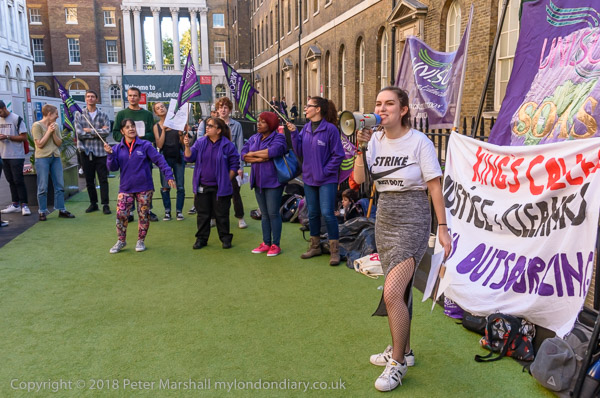
People still keep telling me that “protests don’t work”. And its obviously true that some don’t. Our country still went to war in Iraq despite the largest ever protest against it (and one I was sorry to miss, having come out of hospital the previous day and still being unfit, though I had photographed various other protests against the war previously.) But I’ve always felt that protest could have stopped us going to that war with better leadership of the movement. I do sometimes wonder if there were people in the pay of the intelligence services among them who deliberately let the moment slip. But many protests do acheive their aims, and others provoke and promote important debates and help to change public attitudes and political policies.
Some of the most succesful protests I’ve been involved with over the years have been by low paid workers, calling for better pay and conditions of service. Many of them have been organised by small grass-roots unions, but a few like at King’s College by more determined branches of a major union, in this case Unison. Although often they involve only small numbers of workers, for these people the gains can make huge differences to their lives, both in pay and in satisfaction with their jobs and in health and safety at work.
Some of these campaigns have had almost immediate success, with companies recognising the reasonable demands of the workers and, having been alerted to the Dickensian practices of contracting companies wanting to distance themselves and their reputations from these. Others have been long and hard fought, with Unison at SOAS fighting for over ten years to get workers brought into direct employment, though considerable gains were made on the way; the University of London central administration at Senate House is still dragging its feet. Universities seem less concerned about their reputations than many private firms, or perhaps they simply have more board members with entrenched views.
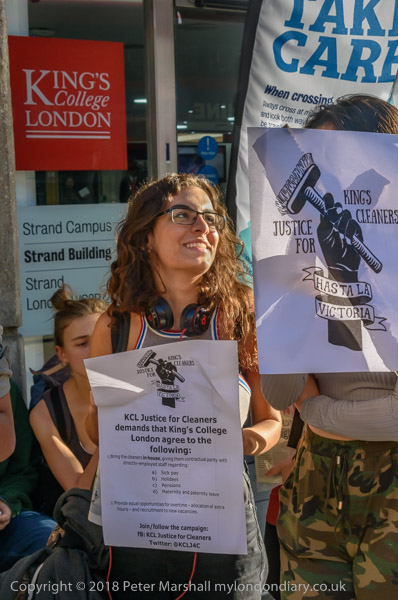
The event at King’s started on the pavement outside the college in the Strand, where students including the KCL Intersectional Feminist Society were running a lively protest. The pavement gets very busy during the rush hour and police came to try and move the students who insisted on continuing the protest but did try to prevent the pavement being blocked. The police also eventually led away a man who had come to argue with the students; I could make no sense of what he was saying and was unsure whether he simply had mental health problems or was a fascist trying to provoke them as the students said.
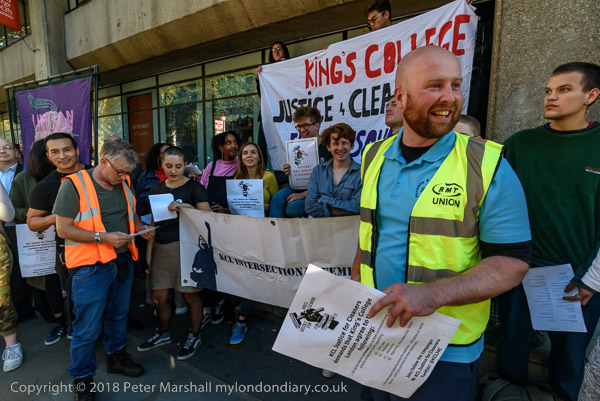
More welcome as visitors were two RMT members, who had been attending a strike meeting nearby, and stopped to express their support for the cleaners. The RMT has been active in supporting its own low paid workers and against management victimisatino of their trade union representatives – a major problem in many of the disputes by low-paid workers.
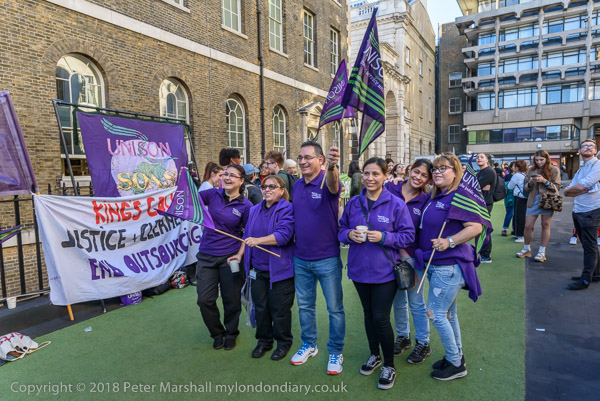
The students then decided to go inside King’s College to join the cleaners who were waiting outside the meeting. Those outside who were not members of the college, including myself, were signed in as guests to go through the security barriers and we joined the cleaners inside.
Apart from being pleased to see the cleaners, many of whom I knew from previous events, things also became rather easier photographically. There was far more space and it was easier to move around than on the crowded pavement – though the crowds perhaps made for more interesting images. But importantly the lighting was much easier to work with – though again less dramatic.
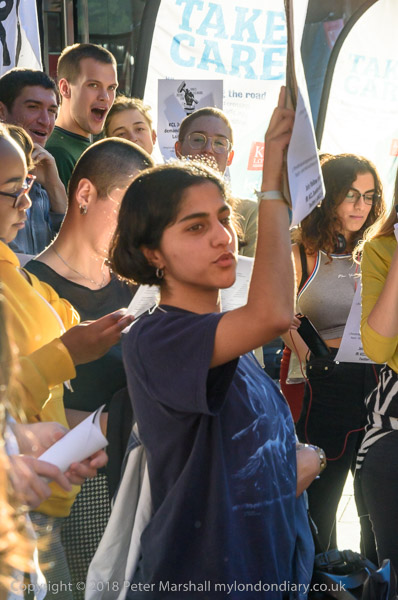
On the Strand, as this picture shows, the sun was low and shining directly along the street, giving deep shadows and often excessive flare. Photographing into the sun gave more dramatic images, and it was sometimes possible to hide the sun behind banners or placards, but it made photography difficult. Taking pictures with my back to the sun was easier, but many of the pictures had both areas in bright sun and those in deep shade.
Had I been making portraits I might have used fill flash, but with wide-angle images this isn’t really practicable, and I had to rely on processing to bring up the shadows and take down the highlights, often with some additional dodging and burning. For the backlit images local use of Lightroom’s ‘De-haze’ was essential. Lightroom continues to improve both in functionality and in ease of use, though I didn’t welcome the recent news that future versions would abandon support for Windows 7, still by far more usable than Windows 10.
Inside King’s, the height of Somerset House’s East wing (where the council meeting was taking place) and the low sun kept the area in shade. Less dramatic but much easier. I’m sure there is some kind of moral in this!
More at Kings College workers await council decision.
______________________________________________________
There are no adverts on this site and it receives no sponsorship, and I like to keep it that way. But it does take a considerable amount of my time and thought, and if you enjoy reading it, a small donation – perhaps the cost of a beer – would be appreciated.
My London Diary : London Photos : Hull : River Lea/Lee Valley : London’s Industrial Heritage
All photographs on this and my other sites, unless otherwise stated, are taken by and copyright of Peter Marshall, and are available for reproduction or can be bought as prints.
To order prints or reproduce images
________________________________________________________